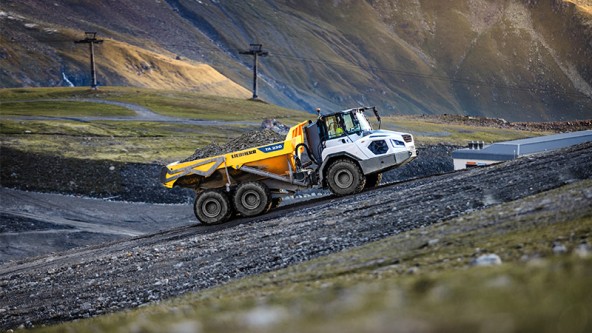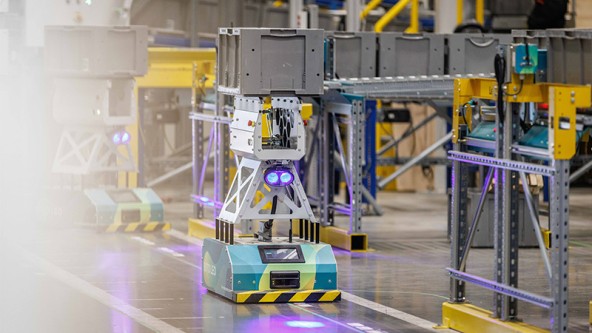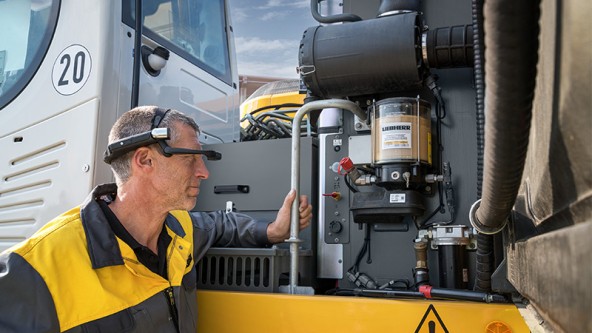
Business performance
The Group in 2023
The Liebherr Group achieved record revenue of €14,042 million in 2023. This represents an increase of €1,453 million, or 11.5 %, compared with the previous year.
Revenue worldwide € m
Overall economic performance
According to the International Monetary Fund, global economic growth slowed to 3.1 % in 2023.
The ongoing impacts of the coronavirus pandemic, the war in Ukraine and the rising cost of living have continued to have a negative impact on the global economy. There was, however, some slow recovery from these challenges. The economy was more resilient than presumed in the face of war-related market disruption and tightened monetary policy. Although global economic growth slowed and has not yet returned to pre-pandemic levels, it did not become stagnant. Having reached a peak in 2022, inflation fell again in the business year. This decline was propelled by more moderate energy and food prices and the recovery of supply chains.
Overall, there continued to be slight growth in the global economy. This was evident, in particular, in emerging market and developing economies, which grew by 4.1 %, whereas industrialised countries only recorded growth of 1.6 %. Particularly striking here is the small increase of 0.5 % in the eurozone – compared to 2.5 % growth in the US economy.
In the 2023 business year, Liebherr once again achieved record revenue with €14,042 million. The Group recorded considerable revenue increases in almost all product segments, with the only exceptions being the deep foundation machines and tower cranes product segments.
In construction machines and mining, Liebherr achieved revenue of €9,557 million, which represents an increase of 11.6 % on the previous year. This includes the product segments of earthmoving, material handling technology, deep foundation machines, mining, mobile and crawler cranes, tower cranes and concrete technology. In the product segments of maritime cranes, aerospace and transportation systems, gear technology and automation systems, refrigerators and freezers, components and hotels, the Group generated combined revenue of €4,485 million. This equates to an increase of 11.3 % compared to the previous business year.
Growth was driven primarily by substantial sales of mobile cranes, mining excavators, wheel loaders, material handling machines and components for the aerospace product area. The decline in residential construction resulted in a downward trend in the tower cranes segment. Besides this, the major challenges of the last year included the uncertain political climate and persistently high inflation and interest rates.
Revenue performance by region
Revenue 14,042 € m
+ 11.5 % + 1,453 € m
| % the previous year | € the previous year | ||
|---|---|---|---|
| Asia and Oceania | 2,233 € m | + 22.2 | + 406 m |
| Africa, Near and Middle East | 936 € m | + 18.8 | + 148 m |
| Central and South America | 537 € m | + 0.0 | + 0 m |
| North America | 2,446 € m | + 22.5 | + 450 m |
| Non-EU countries | 1,383 € m | - 9.7 | - 148 m |
| European Union | 6,507 € m | + 10.1 | + 597 m |
The Liebherr Group’s revenue developed positively in almost all sales regions in the 2023 business year. There was an encouraging increase in revenue in the European Union, traditionally Liebherr’s strongest market. Business was particularly positive in Germany, France and Spain. The Group recorded a minor decline in the non-EU countries. The business year was extremely encouraging in North America – driven by the USA and Mexico – and also in Asia and Oceania, particularly in Australia, Indonesia and China. Revenue in the Africa, Near and Middle East region was also well above the previous year’s level. In Central and South America, revenue remained at the previous year’s level.
Net income for the year
In 2023, the Liebherr Group achieved a net income of €367 million. The operating result increased compared to 2022 and the finance result grew significantly compared to the previous year’s level.
Employees
53,659
+ 2,338
| Employees | Compared to the previous year | ||
|---|---|---|---|
| Asia and Oceania | 4,542 | + 378 | |
| Africa, Near and Middle East | 1,207 | + 62 | |
| Central and South America | 1,984 | - 4 | |
| North America | 2,290 | + 226 | |
| Non-EU countries | 4,385 | - 379 | |
| European Union | 39,251 | + 2,055 |
The Liebherr Group’s employees are key to its success. Their qualifications, commitment and determination to produce first-class results for the Group’s customers mean that they are the ones who decisively shape the company. As a family-run company, Liebherr is an employer with a strong tradition of partnership and teamwork based on reliability, fairness, respect and autonomy.
The number of employees in the Group increased again in the business year. At the end of 2023, Liebherr employed 53,659 people worldwide, which represents an increase of 2,338 employees or 4.6 % on the previous year. The European Union saw the largest increase in the number of employees. The figure fell in the non-EU countries. Liebherr also recorded a slight decline in Central and South America. The number of employees rose compared to the previous year in North America, the Africa, Near and Middle East region and in Asia and Oceania.
The Group is regarded as an attractive and reliable employer. Liebherr creates exciting professional challenges and opportunities for employees to nurture their passion for fascinating, innovative products and technologies through the diverse tasks they perform in their day-to-day work. A whole host of opportunities await employees starting their working life, ranging from apprenticeships to dual study, to a final thesis or traineeship opportunities.
Sustainability
The Group aspires to generate sustainable value for its employees, customers and suppliers, and for society as a whole. As an independent family-run company with a long-term focus, Liebherr is aware of its responsibilities and is committed to sustainable development. Its products, processes and infrastructure are geared to the minimum possible consumption of resources. The focus in all areas is on safety, efficiency and environmental sustainability. Last year, a large number of the Group’s companies worked on projects concerning social, environmental and economic aspects of sustainability. The many activities in these areas will be incorporated into an overall concept for corporate responsibility, which is currently being developed at Group level.

Research and development
As a high-tech company, Liebherr aims to play a major role in advancing technological innovation. In the 2023 business year, the Group therefore invested €634 million in its research and development activities. A large pro- portion of this amount went into new product development. Numerous research projects with universities, higher education institutions and research institutes were initiated or carried forward. The research and development activities continued to focus on alternative drives, digitalisation and autonomy. Liebherr further developed its existing technologies in 2023 and add numerous new machines, components and solutions to its product programme.
Liebherr consistently pursues an open approach to technology in order to support its customers in achieving their emissions targets and meeting future environmental standards. The Group researches and develops solutions such as electric drives, alternative fuels for combustion engines, for example hydrogen and ammonia, and hydrogen fuel cells.
Various electrically powered machines took centre stage for the construction site of the future in the business year. This included not only sales getting under way for the first battery-electric Liebherr wheel loader L 507 E, but also the first delivery of the new LH 80 M High Rise Industry electric material handling machine. In the maritime cranes product segment, the CBG 500 E transshipment crane commenced operation and the LS800E became the first fully electric heavy-lift crane currently in production.
In the components product segment, Liebherr prepared for the series production of the Liduro Power Port mobile energy storage system for mobile power supply, which is scheduled to begin in 2024. This was successfully tested for a range of customer requirements. The Betomix and Mobilmix mixing plant series have already been in operation since 2023. These offer greater dosing accuracy and consume up to 30 % less energy than their predecessors, resulting in savings for raw materials, time and CO2 emissions.
In aerospace, there is also a focus on alternative technologies for generating electrical energy for the propulsion and power supply of future aircraft. Liebherr installed a test bench in Toulouse (France) that uses fuel cells to generate electrical power for the non-propulsion systems of next-generation aircraft. Futhermore, Liebherr entered into an agreement with Eve Air Mobility to supply electro- mechanic actuators for the flight control system of the Eve eVTOL aircraft. The actuators with fully integrated electronics are among the first in the world to be used for primary flight control.
In the business year, Liebherr also invested in various digital platforms to give customers greater reliability, convenience and efficiency when operating machines. The Tower Crane Portal was fully integrated into the MyLiebherr customer portal. The Crane Finder, which helps find the right mobile and crawler cranes for specific lifting tasks, and the MyNotifier application were also developed further. MyNotifier informs the machine operator of the wind conditions or supplies status information for the high-voltage battery and charging process, thus enabling more efficient and safer crane operation. Development of the pioneering Tower Crane Operating System 2 for a large number of bottom-slewing cranes also continued.
Liebherr also expanded its digital offering in the earthmoving and material handling technology product segments. The MyGuide for Earthmoving app brings together product information and news from these two segments, provides an interface with the product configurator and enables users to easily contact Liebherr sales and service partners.
In addition to alternative drives and digitalisation, Liebherr is also focused on autonomy and automation. The latest series of mobile harbour cranes features the MasterV crane control system, which provides the basis for integrating future assistance and partial automation systems. As part of the ZIRKEL research project, Liebherr is developing automated disassembly processes for battery packs from electric vehicles. These processes are needed to achieve high recycling rates and to establish carbon-neutral battery production throughout the process chain for the long term. In the field of automation, the LiReCon teleoperation unit was also further developed and tested, and autonomous T 264 mining trucks entered into operation for validation testing with a customer in Australia.
Investments € m
Investments
Liebherr has a tradition of regular investment in its production sites and its global sales and service network. In the business year, Liebherr made record investments of €1,030 million, which represents an increase of €167 million or 19.4 % compared to the previous year. This was offset by depreciation amounting to €623 million.
The company site at Liebherr-Werk Ehingen (Germany) is currently being expanded to create more space for mobile and crawler crane production due to rising demand. A new training workshop is also being built and the warehouse areas are being redesigned with the latest technical equipment. Liebherr-Logistics GmbH in Oberopfingen (Germany) has also invested in improved storage facilities. The highly automated logistics centre has been expanded with a new cold hall and a hazardous materials storage facility for lubricants. At the site in Newport News (USA), the Group has invested in the production of mining trucks. In addition to a new painting facility, the focus is on expanding the existing production hall, with work expected to be completed in 2025. Building work also began at the Campsas site (France) in the business year, in order to enlarge the Liebherr-Aerospace site there
Depreciation € m
Depreciations
In Schüttorf (Germany), Liebherr is building a subsidiary for the sales, maintenance, repair and leasing of earthmoving machines on an area of almost 18,000 m2. This will replace the sites in Lingen and Münster (Germany) and is scheduled to be completed this business year. The heating and cooling for the new administration building and the workshop hall will be provided by heat pumps, and solar panels on the roof of the workshop hall will supply the subsidiary with power.
Elsewhere, Liebherr acquired Zimmermann-Optik GmbH, one of the largest sales partners of Leica Geosystems in Germany. With this move, the Group is investing in its range of services for machine control systems. A new administration building is also being built at the Biberach site (Germany), which Liebherr-Purchasing Services GmbH and Liebherr-International Deutschland GmbH will use for group-wide activities.

Risk management system and internal control system
In order to ensure that the Group’s success continues to be sustainable, opportunities and risks are identified at an early stage for evaluation and control. The Group has a continually optimised risk management and internal control system in place to help it meet operational, market-related and legal requirements.
All managers responsible for the risk management and internal control systems used in the individual Group companies are involved in ensuring the integrated recording, analysis and evaluation of risks. Risks are identified and assessed locally in the individual companies, then countermeasures to limit the risks are introduced and the impacts are evaluated.
This localised approach also makes it possible to identify and assess areas of opportunity efficiently. The information gained about market-related and technological developments is used in opportunities management to reach decisions about future areas of business and production processes.
At the corporate level, the current risk situation is reviewed regularly and the effectiveness of the systems and processes is assessed. The internal audit department monitors compliance with Group guidelines and the implementation of the risk management and internal control systems.
Events after balance sheet date
Events of particular significance which occur after the reporting date should be recorded here, along with their expected impact on the Group’s assets, financial position and financial performance. There were no events of special significance within the Liebherr Group after the close of the 2023 business year.

Outlook for 2024
The International Monetary Fund has forecast that global economic growth will stabilise at 3.1 % in 2024, meaning that it will still be below the average of 3.8 % for the years 2000 to 2019. Economic growth in industrialised countries is expected to weaken slightly to 1.5 %, with stable growth of 4.1 % anticipated in emerging market and developing economies. The World Bank, by contrast, expects global growth to slow to 2.4 % and thus remain significantly below its potential for the rest of the 2020s, provided no corrective measures are taken.
As inflation has peaked, forecasts by the International Monetary Fund expect it to decline steadily, mainly due to tighter monetary policy. However, the World Bank’s outlook for the current year expects that inflation will not return to the targets set by central banks until 2025 and will remain above the average for 2015 to 2019.
At the end of 2022, the Euroconstruct research network predicted the stagnation of European construction output in 2023 and 2024. The consequences of interest rate rises and the war in Ukraine dampened the outlook. For the business year in question, Euroconstruct indicated a decline of 1.7 % at the end of 2023. It is also expected that this will intensify in 2024.
In the aerospace industry, the level of global passenger traffic in 2023 approached that of 2019, according to the International Air Transport Association (IATA). The number of air passengers is expected to have fully recovered by the end of 2024.
Economic conditions will remain challenging in 2024, however Liebherr has started the new business year with a very solid order backlog. Although there are differing trends in the individual product segments, Liebherr will be able to compensate for this thanks to its decentralised, diversified structure and international positioning. The demand for large cranes and raw materials is growing as numerous economies around the world undergo transformation processes. This provides market opportunities for Liebherr. The Group anticipates growth in the USA and Australia, for instance.
In order to successfully leverage these and other opportunities, Liebherr will again continue to forge ahead with the development of new products and technologies in 2024. Back in 1949, market opportunities persuaded Hans Liebherr to develop the first mobile tower crane and thus lay the foundations for the Group as it stands today. Liebherr will celebrate its 75th anniversary in 2024 with the motto of ‘75 years of moving forward’, recalling the special pioneering spirit that has continued to make Liebherr’s many successes possible to this day.
Individual opportunities and risks
To describe individual opportunities and risks, similar types of risks and opportunities have been grouped together.
In macroeconomic terms, the decline in inflation rates and the anticipated decline in interest rates may contribute to a reduction in uncertainty and result in an increase in demand in various industrial sectors in which the Liebherr Group is active. Order intake is continuing to develop positively across all product segments.
There are also simultaneous macroeconomic uncertainties related to the duration and extent of the expected recovery of the German economy and the expected decline in economic activity in China. Further unpredictable factors include the duration of price fluctuations for many goods and services, shortages of certain raw materials and labour and bottlenecks in various supply chains.
The conflict in the Middle East and the war in Ukraine may have negative impacts on sales performance and lead to the disruption of supply chains and energy supplies or to bottlenecks for components, raw materials and intermediate products. In light of this, negative impacts on the Group’s activities cannot be ruled out.
In terms of corresponding risks, the Group may face changes in costs, notably in energy prices, as a result of these macroeconomic uncertainties. Risks may also be triggered by climate-related or geopolitical shocks, which cannot always be compensated for by price indexation.
The chapters on each of the product segments contain detailed reports on relevant opportunities and risks.
Liebherr monitors these risks continuously and uses appropriate financial instruments to hedge selected transactions. The Group enters into financial transactions only where these are linked to its operational business activity or for hedging. In principle, Liebherr does not conduct transactions of a speculative nature.
The global orientation of the Group’s business activities, together with its broad product diversification and the risk management system, ensure that the relevant risks are kept under control. Based on currently available information, there are no further identifiable risks which could have a substantial detrimental effect on Liebherr’s assets, financial position and financial performance in the 2024 business year, and threaten the survival of the Group as a whole.



